#Analyzing Fundamental Data
Text

This blog serves as a user-friendly guide for those just stepping into the world of forex trading. It meticulously breaks down the concept of forex trading signals, highlighting their immense value for beginners in navigating the intricate forex market. It emphasizes the advantages of using signals, such as their potential to save time, reduce emotional stress, and offer a learning opportunity for novice traders. Throughout the guide, the presence of Funded Traders Global as a supportive and educational partner is evident, ensuring that beginners gain confidence in their learn more...
#Analyzing Fundamental Data#Basics of Trading Signals#Candlestick patterns#Complete Guide to Forex Trading Signals for Beginners#currency pairs#Defining Forex Trading Signals#dojis#economic calendars#economic indicators#engulfing candles#Evaluating Sentiment Indicators#Forex charts#Forex News Sources#forex trading 2023#Forex Trading Signals for Beginners#Fundamental Analysis Signals#hammers#How to Choose a Reliable Provider#How to Find Forex Trading Signals#Interpreting Forex Trading Signals#MACD (Moving Average Convergence Divergence)#Market Analysis Tools#Market Sentiment Indicators#mood and perceptions of traders in the market#moving averages#Position Sizing Strategies#Risk Management in Forex Trading#RSI (Relative Strength Index)#Self-Analysis and Research#Sentiment Analysis Signals
0 notes
Text
There's a lot this article touches on, but the parts about fossil preparation are kind of in poor taste. I'll go over some of it under the cut.
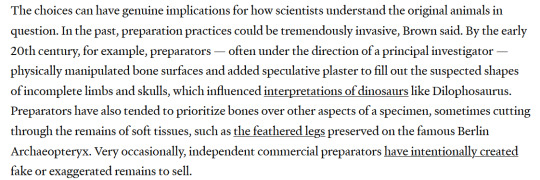
There's a reason we usually don't publish on things we prepare. They say it right here - we can literally, whether purposeful or accidental, modify fossils as we see fit. We could imitate pathologies or create marks with air scribes or picks that are misinterpreted as pathologies, remove or obscure parts of a fossil that may be diagnostic, etc. (Of course we don't endear to do these things, they're just possible).
Whether through inexperience or poor dexterity some budding preparators can cause damage that only someone with a trained eye could notice. Preparators aren't always required to be trained in the sciences or have thorough anatomical knowledge, and thus can reconstruct things wrong, without scientific guidance. Like filling holes where there's supposed to be… holes! Like a fenestrum or foramen, for example. This is why we have references, but more importantly, we do the minimum unless instructed to do otherwise by a supervisor or exhibits team - one of a few scenarios where a curator can rightfully step in.

This is why we're trained to preserve almost any bone we see. Often there are small isolated bone chunks hovering in matrix that are thrown in a box with the specimen. A lot of pieces can't be reattached because they're too weathered or of indeterminate origins (“IBF’s” for short).
"Creating" something "artistic" is another way of implying we're making it up as we go.

If someone hands me a fossil and tells me to look at this "multimedia sculpture", I'd be confused. It's a fossil, not an art project.
Academic fossil preparation is fundamentally a scientific endeavor that also requires artistic abilities, but not creativity. We use various methods that are tried and true (and sometimes experiment with new ones) to expose an element from matrix.
The act of preparing a fossil is not providing new data. The fossil itself is the data. We just make it available. That being said, if we provide measurements, take and analyze samples of the matrix for various analyses, then that's providing valuable data. Would that warrant an authorship? Maybe.
This raises another question though. If anyone who worked on a fossil gets an authorship, then can authorship compound?
The person who found the fossil but didn't do anything with it afterwards - just dug it up and sent it to the lab, for example. Do they get to be an author? On our field crews we have up to 30 people over the whole season. 30 coauthors and 99% of them are not scientists.
The collections manager who just painted a number on it, catalogued it, and put it away?
How about the curator who allowed a researcher access to the collection who didn't collect any data but just answered some emails and opened the drawer for it to be studied?
The land owner who gave you permission to dig?
Finally, the preparator who just exposed it from the rock. They do more science inherently than the others, but if no parts of the scientific method were conducted and no data was produced (save for the fossil simply being brought back into the world), do they get an authorship?
tl;dr We don't need authorships for the act of preparing fossils unless we provide data and go through the scientific process (like what's usually required for any authorship). Many parts of the process is not science. Just acknowledge our work in your paper and we'll be more than happy.
#fossil preparator#fossil preparation#science#paleontology#palaeontology#paleoblr#palaeoblr#fossil prep#fossils#dinosaurs#fossil
197 notes
·
View notes
Text




Reading List: Spirituality, Globalisation, Parenting and the 0.99 Cent Pricing Bias
What I’ve read (🖤) and planning to read (🤍)
Books
• Fall of human intellect - A Parvasarthy (genre: spirituality, humanness) 🖤
Academic Papers
The backlash against globalisation - Stefanie Walter (from annual review) 🤍
In recent years, the world has seen a rising backlash against globalization. This article reviews the nature, causes, and consequences of the globalization backlash. It shows that, contrary to a popular narrative, the backlash is not associated with a large swing in public opinion against globalization but is rather a result of its politicization. The increasing influence of globalization- skeptic actors has resulted in more protectionist, isolationist, and nationalist policies, some of which fundamentally threaten pillars of the contemporary international order. Both material and nonmaterial causes drive the glob- alization backlash, and these causes interact and mediate each other. The consequences are shaped by the responses of societal actors, national gov- ernments, and international policy makers. These responses can either yield to and reinforce the global backlash or push back against it. Understanding these dynamics will be an important task for future research.
The causes and consequences of urban riot and unrest - Tim Newburn (from annual review) 🤍
This review explores those varied bodies of work that have sought to un- derstand crowd behavior and violent crowd conduct in particular. Although the study of such collective conduct was once considered central to social science, this has long ceased to be the case and in many respects the study of protest and riot now receives relatively little attention, especially within criminology. In addition to offering a critical overview of work in this field, this review argues in favor of an expanded conception of its subject matter. In recent times, scholarly concern has increasingly been focused on ques- tions of etiology, i.e., asking how and why events such as riots occur, with the consequence that less attention is paid to other, arguably equally impor- tant questions, including how riots spread, how they end, and, critically, what happens in their aftermath. Accordingly, as a corrective, the review proposes a life cycle model of riots.
Parenting and it’s effects on children : reading and misreading behaviour genetics (from annual review) 🖤
There is clear evidence that parents can and do influence children. There is equally clear evidence that children’s genetic makeup affects their own behavioral characteristics, and also influences the way they are treated by their parents. Twin and adoption studies provide a sound basis for estimating the strength of genetic effects, although heritability estimates for a given trait vary widely across samples, and no one estimate can be considered definitive. This chapter argues that knowing only the strength of genetic factors, however, is not a sufficient basis for estimating environmental ones and indeed, that attempts to do so can systematically underestimate parenting effects. Children’s genetic predispositions and their parents’ childrearing regimes are seen to be closely interwoven, and the ways in which they function jointly to affect children’s development are explored.
More than a penny’s worth: left-digit bias and firm pricing- Avner Strulov-Shlain (from MorningBrew) 🤍
A penny saved. What’s the difference between $2.99 and $3.00? Basic math says one cent, but you probably perceive the difference to be about 22 cents, a new paper by a University of Chicago business school professor estimated. The research explores left digit bias—the phenomenon where consumers’ perceptions are overly influenced by the leftmost number in the price—and it brought receipts, analyzing retail scanner data on 3,500 products sold by 25 US chains. And while it might seem like every price you see ends in .99, the paper argues that retailers are leaving money on the table by underestimating this bias when setting prices.
#c suite#powerful woman#strong women#ceo aesthetic#personal growth#c suite aesthetic#working woman#beauty#empire#that girl#books#academic papers#parenting#globalisation#99 cents#0.99 marketing#marketing strategy#riots#spirituality#spiritual books
211 notes
·
View notes
Text
A new report adds to a growing line of research showing that police departments don’t solve serious or violent crimes with any regularity, and in fact, spend very little time on crime control, in contrast to popular narratives.
...
More notably, researchers analyzed the data to show how officers spend their time, and the patterns that emerge tell a striking story about how policing actually works. Those results, too, comport with existing research showing that U.S. police spend much of their time conducting racially biased stops and searches of minority drivers, often without reasonable suspicion, rather than “fighting crime.”
Overall, sheriff patrol officers spend significantly more time on officer-initiated stops – “proactive policing” in law enforcement parlance – than they do responding to community members’ calls for help, according to the report. Research has shown that the practice is a fundamentally ineffective public safety strategy, the report pointed out.
...
Decades of data similarly shows that police don’t solve much serious and violent crime – the safety issues that most concern everyday people.
Over the past decade, “consistently less than half of all violent crime and less than twenty-five percent of all property crime were cleared,” William Laufer and Robert Hughes wrote in a 2021 law review article. Laufer and Hughes are professors in the Wharton School of the University of Pennsylvania’s Legal Studies and Business Ethics Department.
Police “have never successfully solved crimes with any regularity, as arrest and clearance rates are consistently low throughout history,” and police have never solved even a bare majority of serious crimes, University of Utah college of law professor Shima Baradaran Baughman wrote in another 2021 law review article, including murder, rape, burglary and robbery.
Existing research also affirms the findings in the recent report on police work in California.
Law “enforcement is a relatively small part of what police do every day,” Barry Friedman, a law professor at the New York University School of Law wrote in a 2021 law review article.
Studies have shown that the average police officer spent about one hour per week responding to crimes in progress, Friedman wrote.
Police spend most of their time on traffic violations and routine, minor issues, like noise complaints, according to three different, recent analyses of dispatch data from Los Angeles, Baltimore, Detroit, New Orleans, Seattle, and New Haven, Connecticut.
The New York Times reviewed national dispatch data from the FBI in June 2020, and found that just 4% of officers’ time is devoted to violent crime.
“We hope the report helps reshape the narrative about the relationship between law enforcement and safety,” Smith told me. Californians “should understand that a reimagination of community safety is far overdue and that equitable and community-centered solutions” are more effective alternatives.

73 notes
·
View notes
Text
So, Canto 5. Spoilers.
Peak fiction, utterly incredible. My following thoughts will be jumbled but forgive me.
I've sadly not finished the source material, so I won't analyze it from that POV, but just to discuss the continued building of the world of the City, the Great Lake is so well conceived as a setting. The individual Lakes and their Waves, and the Whales that cause them, the variable coordinates and U Corp's monopoly on written data of Laws. You could make a whole damn RPG on the back of this stuff alone, I know TTRPG heads are looking at this and coming up with some homebrews.
I wonder if the Lakes are actually the result of the Whales changing the waters around them? Ishmael theorizes that the Whales parasitize humans out of loneliness, to make others like them (which of course reflects on Ahab as a Whale) and I wonder if the waters of the lake are similarly changed to reflect the Whale? And then I think about how Ahab turned the inside of the Pallid Whale into Pequod Town gah the subtext.
I'm also thinking more about the Sinners as a found family. While they've gotten on well enough since Verg put his foot down it's becoming clearer as time goes on that real bonds are forming. Ishmael was certainly straining those bonds but its a testament to them that they grew stronger after she found peace. I was pleasantly surprised she and Outis found a dynamic as fellow seawomen leading to mutual respect, not to mention what's going on between Heath and Ish (I have never shipped anything harder in my life). And then there's the individual relationships to Dante. Dante and Ish have gotten over the hump, and while she says that if they ever go in the wrong direction "she'll drop a skiff and depart" I feel like Ish is invested in Dante as a friend and will be there for them no matter what, including steering them back on the right course.
We saw it in S.E.A., but it's dawning on me that we get to experience characters post arc and that there are consequences to that. It didn't feel that way as strongly with Canto 1 - 3 because Gregor and Rodya are thoroughly still cooking on their issues and Sinclair feels like he's started his arc to becoming more confident and capable (the part where he actually threatens that guy is just chef's kiss). But we saw a Yi Sang who's actively trying to preserve his new friend group and find the bright side of things. Now we'll have a collected Ishmael who can keep it together and is firmly on Dante's side, which will be amazing come the Heartbreaking if the Heathmael dream is real.
Rapid fire thoughts in no particular order:
Ahab VA is perfect casting, her character is phenomenal, and I can't wait to see how she'll do on Hermann's team. PM is carrying the torch of insane old ladies.
I'm increasingly certain that the plot of Limbus will be ultimately about the multiverse (IN A GOOD WAY) and the goals of the villains and other groups deals with mirror worlds in some way.
I'm thinking about the other 3 Calamities of the Lake, Whales that attack without rhyme or reason. I have to imagine them as other great beasts of literature, so one surely is the Crocodile from Peter Pan. Possibly another is the Dogfish from Pinocchio (adapted as Monstro in the Disney version). Then I don't know, the Giant Squid from 20'000 Leagues Under the Sea (or maybe the "Narwhal" itself)? There's many possibilities.
I enjoy the Middle as a faction, they fit in with the deeply absurdist nature of the City and feel distinct from the other Fingers we know about. Makes me wonder what the actual fuck the Pinky's deal is if they're the worst Finger (iirc).
Love the feeling of Faust and Verg as outsiders Red Fraud Alert there's no way it doesn't come to a head at some point where Vergilius and the group are fundamentally at odds but the group is strong enough that threats won't cut it.
Compass is fire. Love that we're seeing different fan remixes combining the vocal and instrumentals in interesting ways, though I worry for the official version. Fly, Broken Wings doesn't work as well when it just goes through the whole thing without repeating the Broken Wings part, I much prefer an edit that matches the in game version more. I hope Mili sees what people are doing and gives us the heartbeat.
Praying to god we get a Stubb or Pip Outis ID with Pequod Captain Ishmael, but that will likely be end of season. I predict Ish ID to be a powerful SP support ID and will likely be as meta as Nclair (which is cool but also kinda unfortunate narratively, there are some downsides to the Gacha format).
Sentences like "Ishmael totally tops Heathcliff, that guy would turn into a puppy dog at the slightest hint of affection" are insane things I believe wholeheartedly and I love every time a literature person stumbles upon it and has to wrestle with this surprisingly valid crackship not knowing its origin.
All for now but I'm sure I'll think of something else later, can't wait for the Christmas Event (which will likely drop after Christmas but c'est la vie).
34 notes
·
View notes
Text

Scientists trap krypton atoms to form one-dimensional gas
For the first time, scientists have successfully trapped atoms of krypton (Kr), a noble gas, inside a carbon nanotube to form a one-dimensional gas.
Scientists from the University of Nottingham's School of Chemistry used advanced transmission electron microscopy (TEM) methods to capture the moment when Kr atoms joined together, one by one, inside a "nano test tube" container with diameter half a million times smaller than the width of a human hair. The research has been published in ACS Nano.
The behavior of atoms has been studied by scientists ever since it was hypothesized that they are the basic units of the universe. The movement of atoms has significant impact on fundamental phenomena such as temperature, pressure, fluid flow and chemical reactions.
Traditional spectroscopy methods can analyze the movement of large groups of atoms and then use averaged data to explain phenomena at the atomic scale. However, these methods don't show what individual atoms are doing at a specific point in time.
Read more.
#Materials Science#Science#Krypton#Gases#1D materials#Carbon nanotubes#Transmission electron microscopy#Carbon#Nanotubes#Nanotechnology#Atoms#University of Nottingham
18 notes
·
View notes
Note
i am glad you still love your supercomputer au! your fanfiction and the pieces you created once is such masterpieces... your old curiouscat link gave an error so i cannot see the answers you gave to people. can you generally tell the au shortly? akiras relationships with phantom thieves, futaba and akiras relationships etc etc
aaaa thank you!! and im sorry so much was on curiouscat that i didn't back up ;o; but i can definitely give a brief overview as well as go into a little more detail about akira!!
for some background, akira was an orphaned child used in the cognitive pscience experiments, as he showed great potential in preliminary testing (ie, what would become his wildcard ability) he grew up housed in a facility for this purpose, with his main social contact through the ten years he was there being YAL20XX, a supercomputer designed to analyze data related to the field. frightened and eventually bitter toward the researchers, YAL was programmed to speak to him for them, keeping him content in a way they couldn't while gathering information he refused to give. this back and forth went on long enough that, in YAL's complexity, he grew into sentience and so into hatred for humanity - akira understood his emotions and yal, with full control of the facility, was able to plan their escape and the subsequent work they did on creating the metaverse navigator
the test for humanity is the same as in canon, with akira playing the role of black mask with his persona, mephistopheles. he is an unknown entity to the conspiracy, but his brutal efficiency means they don't bother to question who he might be. akira, as a person, rarely goes out and refuses to make connections with others, believing yal to be the only being he can trust or that can understand him - he is too different, too changed from who he could have been and what everyone else is, and he carries a great grudge for his mistreatment. he believes in the world yaldabaoth promises, and he is sure humanity will ultimately fail their test regardless of the introduction of the phantom thieves to stand against shido
his connection to the thieves is mixed, somewhat limited, but grows increasingly over time - goro is of course who he meets first, becoming a regular at leblanc so yal can keep a close eye on him through a more human lens (and have an agent that can direct him as needed) goro is very much taken by akira's bright intellect and unusual perspective, while akira slowly comes to appreciate goro's tenacity and his willingness to risk everything in his work as a thief. it's not easy for him to make connections or believe others, but goro doesn't give up on pursuing their relationship, he puts his faith in akira and refuses to leave their friendship at a surface level despite akira's coldness. and that's. very hard for akira to accept. he so fully believes in humanity's irredeemable malice and his own fundamental brokenness that he doesn't know how to feel when goro continuously defies those expectations. goro, as well as all the thieves, risk their freedom and their lives over and over again for victims they don't know, to build a better world without ever receiving praise or compensation. and goro listens to akira, engages with him but gives him space too, reaches out to see if he ever wants to join them for a day out or just spend time together. even if akira keeps saying no, goro will text him again soon. the thieves are good people, and akira isn't the unlovable monster he believed himself to be.
futaba is very interesting in the supercomputer au, because i like to think she's the one that tipped goro off to akira being much more than he seemed - largely because whatever he's using, futaba can't hack into it. it makes akira VERY wary of her, keeping his distance from futaba as much as he can without attracting attention, but she just knows something is up with him if he's got a setup she has no way into. i do like the idea that she basically fries her computer to catch a glimpse of yal with his mess of esoteric code, but it's enough to unravel akira's identity (in a much more convoluted way than canon got to lol) - she traces him back to a user known as "bowman" that was snooping similar government databases as she did, making his connection to cognitive psience come to the forefront. this is compounded by her finding out all of akira's identification, from his name to his apparent history, is all faked when dug into. at this point they all know he will have to be confronted, and that leads into the end of the game
sorry that was kinda long ;;;; but i think that about covers it!!! if you have any other questions i'd be happy to answer those too ^^
#i didn't even get to the third semester but#that's a whole other can of worms!!!#but you know doing a roleswap this way#really made me realize how much the plot uses futaba to get around things#and how i couldn't. do that at ALL in this au so i had to do a lot of thinking on multiple points#still can't remember how i worked around the interrogation room. guah#cake answers#supercomputer au
23 notes
·
View notes
Text

Pro-abortion activists fight for abortion throughout pregnancy for any reason—no exceptions. Their fundamental argument centers on women’s health.
But stunning research shows this concern is all smoke and mirrors.
Pro-abortion activists have long tried to claim that abortion is safer than childbirth. For years they’ve touted manipulated numbers, trying in vain to bolster this myth. We’ve always known those statistics were bogus, and a study by Dr. Priscilla Coleman and Dr. David Reardon reveals abortion is much more dangerous to women than giving birth. And the results are sadly even more devastating to women’s health than even I had anticipated.
First, let me vouch for the authors of this research. I know them both to be solid individuals with a reputation for thoroughness. I met Dr. Coleman in Santiago, Chile where we lectured at their largest university. We again shared an academic podium in Quito, Ecuador the following year.
Second, allow me to explain why this study is so important. It’s compelling because of its unmatched scope:
The study includes a large number of women—nearly one-half-million—experiencing first-time pregnancies.
The medical records are profoundly reliable because the data was compiled from Danish government sources including fertility records of births and stillbirths, the national abortion registry and cause of death registry.
The study covers an extensive ten-year time period, providing comprehensive long-term data.
It analyzes both early and late-term abortion compared to childbirth.
In other words, this isn’t a biased study with a relatively small sample size produced to cater to pro-abortion activists—or any side for that matter. This research was conducted at the national level, over the course of a decade, providing substantial credibility, a comprehensive level of detail, as well as earning publication in respected medical journals. The reliability has been substantiated, which is why the results are even more troubling.
When it comes to which is safer—abortion or childbirth—the results speak loudly and clearly:
During the first six months after an early abortion (12 weeks or less), a woman has double the risk of death compared to giving birth.
During the first year following a late abortion (after 12 weeks) a woman has over three times the risk of death compared to giving birth.
Here’s a link to the entire study if you’d like to read it.
Pro-abortion activists prey on the fear of Americans by perpetuating the myth that if Roe v. Wade is reversed, women will suffer horrific back-alley abortions and tragic deaths. The reality is that under legalized abortion, women are being killed on a much larger scale.
Remember when we heard the news that Planned Parenthood is responsible for 24-year-old Tonya Reaves’ death following a botched abortion. Reports showed that a devastating five-and-a-half hours passed between the time of her abortion and her transport to a local hospital.
There’s no record that a 911 call was placed by Planned Parenthood. The autopsy report indicated that her injuries were survivable if she had received proper emergency care in a timely manner. The only difference between her death and a back-alley abortion death is that Ms. Reaves’ abortion was sanctioned by the US Supreme Court, giving her a false sense of security that the procedure was safe.
Now Tonya’s one-year-old son will grow up without a mother. Sadly, there have been additional victims after Tonya’s death. And don’t forget the Gosnell “house of horrors.”
Planned Parenthood and other abortion facilities continue to lure young women under the false premise that they perform “women’s healthcare services.” Abortion isn’t healthcare. It’s killing. In fact, they’re an industry of death—killing unborn babies and exposing their mothers to a staggering increased risk of death. Let’s not let this grave injustice continue. Share this with those you know and take a stand.
You now have compelling proof that abortion is not safer than childbirth
#maternal mortality rate#abortion hurts women#abortion harms women#prolife#pro life#pro-life#anti abortion#abortion#pro women#anti planned parenthood#Pp#planned parenthood#sources#studies#life news#prolife news
98 notes
·
View notes
Text

Econometrics Demystified: The Ultimate Compilation of Top 10 Study Aids
Welcome to the world of econometrics, where economic theories meet statistical methods to analyze and interpret data. If you're a student navigating through the complexities of econometrics, you know how challenging it can be to grasp the intricacies of this field. Fear not! This blog is your ultimate guide to the top 10 study aids that will demystify econometrics and make your academic journey smoother.
Economicshomeworkhelper.com – Your Go-To Destination
Let's kick off our list with the go-to destination for all your econometrics homework and exam needs – https://www.economicshomeworkhelper.com/. With a team of experienced experts, this website is dedicated to providing high-quality assistance tailored to your specific requirements. Whether you're struggling with regression analysis or hypothesis testing, the experts at Economicshomeworkhelper.com have got you covered. When in doubt, remember to visit the website and say, "Write My Econometrics Homework."
Econometrics Homework Help: Unraveling the Basics
Before delving into the intricacies, it's crucial to build a strong foundation in the basics of econometrics. Websites offering econometrics homework help, such as Khan Academy and Coursera, provide comprehensive video tutorials and interactive lessons to help you grasp fundamental concepts like linear regression, correlation, and statistical inference.
The Econometrics Academy: Online Courses for In-Depth Learning
For those seeking a more immersive learning experience, The Econometrics Academy offers online courses that cover a wide range of econometrics topics. These courses, often led by seasoned professors, provide in-depth insights into advanced econometric methods, ensuring you gain a deeper understanding of the subject.
"Mastering Metrics" by Joshua D. Angrist and Jörn-Steffen Pischke
No compilation of study aids would be complete without mentioning authoritative books, and "Mastering Metrics" is a must-read for econometrics enthusiasts. Authored by two renowned economists, Joshua D. Angrist and Jörn-Steffen Pischke, this book breaks down complex concepts into digestible chapters, making it an invaluable resource for both beginners and advanced learners.
Econometrics Forums: Join the Conversation
Engaging in discussions with fellow econometrics students and professionals can enhance your understanding of the subject. Platforms like Econometrics Stack Exchange and Reddit's econometrics community provide a space for asking questions, sharing insights, and gaining valuable perspectives. Don't hesitate to join the conversation and expand your econometrics network.
Gretl: Your Free Econometrics Software
Practical application is key in econometrics, and Gretl is the perfect tool for hands-on learning. This free and open-source software allows you to perform a wide range of econometric analyses, from simple regressions to advanced time-series modeling. Download Gretl and take your econometrics skills to the next level.
Econometrics Journal Articles: Stay Updated
Staying abreast of the latest developments in econometrics is essential for academic success. Explore journals such as the "Journal of Econometrics" and "Econometrica" to access cutting-edge research and gain insights from scholars in the field. Reading journal articles not only enriches your knowledge but also equips you with the latest methodologies and approaches.
Econometrics Bloggers: Learn from the Pros
Numerous econometrics bloggers share their expertise and experiences online, offering valuable insights and practical tips. Follow blogs like "The Unassuming Economist" and "Econometrics by Simulation" to benefit from the expertise of professionals who simplify complex econometric concepts through real-world examples and applications.
Econometrics Software Manuals: Master the Tools
While software like STATA, R, and Python are indispensable for econometric analysis, navigating through them can be challenging. Refer to comprehensive manuals and documentation provided by these software platforms to master their functionalities. Understanding the tools at your disposal will empower you to apply econometric techniques with confidence.
Econometrics Webinars and Workshops: Continuous Learning
Finally, take advantage of webinars and workshops hosted by academic institutions and industry experts. These events provide opportunities to deepen your knowledge, ask questions, and engage with professionals in the field. Check out platforms like Econometric Society and DataCamp for upcoming events tailored to econometrics enthusiasts.
Conclusion
Embarking on your econometrics journey doesn't have to be daunting. With the right study aids, you can demystify the complexities of this field and excel in your academic pursuits. Remember to leverage online resources, engage with the econometrics community, and seek assistance when needed. And when the workload becomes overwhelming, don't hesitate to visit Economicshomeworkhelper.com and say, "Write My Econometrics Homework" – your trusted partner in mastering econometrics. Happy studying!
13 notes
·
View notes
Text

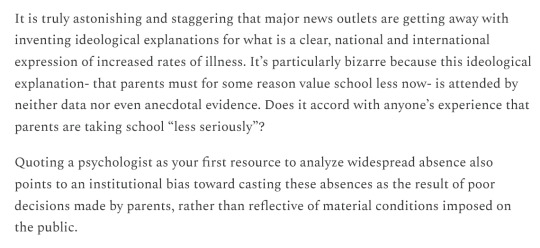
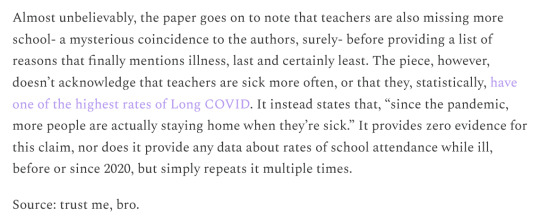
[ID:
Normalizing constant mass reinfection with COVID requires shoving a lot of inconvenient data out of the way. From excess heart attacks and strokes, to falling test scores, to unprecedented rates of long-term illness, to record worker sick days, to overwhelmed hospitals, to increasing student absences, it all has to be buried, denied, or explained away.
With “immunity debt” becoming an increasingly strange explanation as the months and years continue to pass, COVID normalizers need a new culprit to pin sky-high student absences on. This week, the New York Times decided to run with an even flimsier, even less-evidenced explanation for the “post-pandemic” school absence crisis:
underlying it all is a fundamental shift in the value that families place on school, and in the culture of education during the pandemic. “Our relationship with school became optional,” said Katie Rosanbalm, a psychologist and associate research professor at Duke University.
It is truly astonishing and staggering that major news outlets are getting away with inventing ideological explanations for what is a clear, national and international expression of increased rates of illness. It’s particularly bizarre because this ideological explanation- that parents must for some reason value school less now- is attended by neither data nor even anecdotal evidence. Does it accord with anyone’s experience that parents are taking school “less seriously”?
Quoting a psychologist as your first resource to analyze widespread absence also points to an institutional bias toward casting these absences as the result of poor decisions made by parents, rather than reflective of material conditions imposed on the public.
Almost unbelievably, the paper goes on to note that teachers are also missing more school- a mysterious coincidence to the authors, surely- before providing a list of reasons that finally mentions illness, last and certainly least. The piece, however, doesn’t acknowledge that teachers are sick more often, or that they, statistically, have one of the highest rates of Long COVID. It instead states that, “since the pandemic, more people are actually staying home when they’re sick.” It provides zero evidence for this claim, nor does it provide any data about rates of school attendance while ill, before or since 2020, but simply repeats it multiple times.
Source: trust me, bro.
End ID]
9 notes
·
View notes
Text
Confections Pulverizer
Commandant Effyl of Military intelligence began the briefing. Behind and above them was a large viewscreen displaying the galaxy's most popular video game, "Confections Pulverized." Game play involved manipulation of brightly colored geometric shapes so that three or more were aligned orthogonally. Success resulted in pleasant, on screen explosions and increased score. The audience quietly chuckled.
"The incongruity of this briefing is not lost on me." The Commandant began. "No doubt many of you are wondering why Military Intelligence would bother researching such a harmless frivolity. My own subordinates had a difficult time convincing me of the grave threat human malware presented.
“The game on display is relatively harmless. The danger is the underlying code within it. Almost all human programs include instructions to save and transmit user location data. In short, they have turned our electronic devices into little spies that note our every move.”
The viewscreen changed to display military personnel exercising in group calisthenics.
"The coordinates of several secret military bases became known to humans through fitness trackers. Hidden in the code of so-called "health software" is location tracking. Earth government has purchased the data generated by the applications, or apps. These apps are available to consumers free of charge. This data was analyzed and it was noted that users flagged as military service members had begun exercising in a routine manner in remote locations."
The next image was a spinning circle of question marks.
"Trivia games are being used to assess information ubiquity in user populations. Using algorithmic, artificial intelligence, the game learns the depth and breadth of each user's information and skill level. Military Intelligence was informed of this by an arms research group that noticed the trivia categories had gradually shifted from general knowledge questions towards categories that match their professional expertise."
Above the Commandant's head was a sound wave & a timer icon.
"This is an application titled 'Sound Worms.' It is a specific type of trivia game. Players are presented with an audio file of popular music. The task is to identify the composition in the least amount of time. Preliminary reports indicate the data mined from this app aids in the creation of propaganda."
New image is a nine digit number. Straight lines emanate from it to other numbers. Webs and clusters form as the video continues.
"Military Intelligence has been able to purchase data sets from the human malware companies. Displayed behind me are social networks. The deductions and probability extrapolations generated are truly staggering. We are still analyzing the data and will make a full report later”
Icons and symbols referring to romance and sexuality start to flicker onto the screen. Quickly the display becomes a scrolling screen of tiny thumbnail images.
“These are just a small sampling of the countless dating apps that humans have been flooding the personal electronic software market with. I say without exaggeration that they will fundamentally destabilize interstellar society. There are unpleasant and unspoken differences between public morality and private behavior. A staggering amount of politicians and bureaucrats have become susceptible to blackmail and corruption.”
Stifled gasps and nervous laughter from the audience
“Compounding this danger is that the private entities that publish this malware do not properly secure their data networks. Collectives that are not associated with governmental or commercial entities routinely release huge swaths of privileged user information on the galactinet. So far these disclosures have been small in scale and limited in damage. If anyone here has used these services, I implore you to stop at once and delete it from your devices.”
More than half the attendees start pulling out various objects and interacting with operating screens. Some hurriedly leave the lecture hall. Effyl was losing their audience.
“Oh, and one last thing.” The Commandant pulls out their own personal device. “These damn things are recording audio and video without our permission.”
#humans are space orcs#humans are space oddities#humans are aliens#humans are confusing#humans are deathworlders#humans are silly#humans are space australians
140 notes
·
View notes
Text


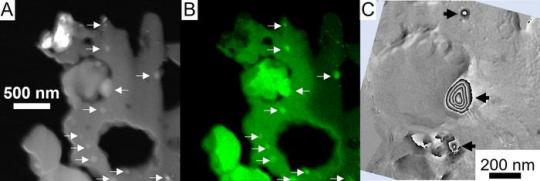
The effects of interplanetary space on asteroid Ryugu
Samples reveal evidence of changes experienced by the surface of asteroid Ryugu, some probably due to micrometeoroid bombardment.
Analyzing samples retrieved from the asteroid Ryugu by the Japanese Space Agency’s Hayabusa2 spacecraft has revealed new insights into the magnetic and physical bombardment environment of interplanetary space. The results of the study, carried out by Professor Yuki Kimura at Hokkaido University and co-workers at 13 other institutions in Japan, are published in the journal Nature Communications.
The investigations used electron waves penetrating the samples to reveal details of their structure and magnetic and electric properties, a technique called electron holography.
Hayabusa2 reached asteroid Ryugu on 27 June 2018, collected samples during two delicate touchdowns, and then returned the jettisoned samples to Earth in December 2020. The spacecraft is now continuing its journey through space, with plans for it to observe two other asteroids in 2029 and 2031.
One advantage of collecting samples directly from an asteroid is that it allows researchers to examine long-term effects of its exposure to the environment of space. The ‘solar wind’ of high energy particles from the sun and bombardment by micrometeoroids cause changes known as space-weathering. It is impossible to study these changes precisely using most of the meteorite samples that land naturally on Earth, partly due to their origin from the internal parts of an asteroid, and also due to the effects of their fiery descent through the atmosphere.
“The signatures of space weathering we have detected directly will give us a better understanding of some of the phenomena occurring in the Solar System,” says Kimura. He explains that the strength of the magnetic field in the early solar system decreased as planets formed, and measuring the remnant magnetization on asteroids can reveal information about the magnetic field in the very early stages of the solar system.
Kimura adds, “In future work, our results could also help to reveal the relative ages of surfaces on airless bodies and assist in the accurate interpretation of remote sensing data obtained from these bodies.”
One particularly interesting finding was that small mineral grains called framboids, composed of magnetite, a form of iron oxide, had completely lost their normal magnetic properties. The researchers suggest this was due to collision with high velocity micrometeoroids between 2 and 20 micrometers in diameter. The framboids were surrounded by thousands of metallic iron nanoparticles. Future studies of these nanoparticles will hopefully reveal insights into the magnetic field that the asteroid has experienced over long periods of time.
“Although our study is primarily for fundamental scientific interest and understanding, it could also help estimate the degree of degradation likely to be caused by space dust impacting robotic or manned spacecraft at high velocity,” Kimura concludes.
TOP IMAGE....Conceptual illustration of the study Credit Yuki Kimura
CENTRE IMAGE....Magnetite (round particles) particles cut from a Ryugu sample. (A) Bright field transmission electron microscopy image. (B) Magnetic flux distribution image obtained by electron holography. The concentric circular stripes seen inside the particles correspond to magnetic lines of force. They are called vortex magnetic domain structures and are more stable than ordinary hard disks, which can record magnetic fields for more than 4.6 billion years. (Yuki Kimura, et al. Nature Communications. April 29, 2024) Credit Yuki Kimura, et al. Nature Communications. April 29, 2024
LOWER IMAGE....Iron nanoparticles distributed around pseudo-magnetite. (A) Dark-field image taken with a scanning transmission electron microscope. (B) Corresponding iron distribution image. White arrows indicate iron nanoparticles. (C) Magnetic flux distribution image of the central region of A and B. No magnetic field lines can be seen in the pseudo-magnetite, whereas concentric vortex-like magnetic domain structures can be seen inside the iron particles as shown by black arrows. (Yuki Kimura, et al. Nature Communications. April 29, 2024) Credit Yuki Kimura, et al. Nature Communications. April 29, 2024
6 notes
·
View notes
Text
In the subject of data analytics, this is the most important concept that everyone needs to understand. The capacity to draw insightful conclusions from data is a highly sought-after talent in today's data-driven environment. In this process, data analytics is essential because it gives businesses the competitive edge by enabling them to find hidden patterns, make informed decisions, and acquire insight. This thorough guide will take you step-by-step through the fundamentals of data analytics, whether you're a business professional trying to improve your decision-making or a data enthusiast eager to explore the world of analytics.
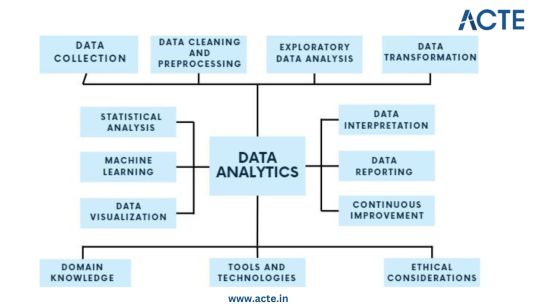
Step 1: Data Collection - Building the Foundation
Identify Data Sources: Begin by pinpointing the relevant sources of data, which could include databases, surveys, web scraping, or IoT devices, aligning them with your analysis objectives.
Define Clear Objectives: Clearly articulate the goals and objectives of your analysis to ensure that the collected data serves a specific purpose.
Include Structured and Unstructured Data: Collect both structured data, such as databases and spreadsheets, and unstructured data like text documents or images to gain a comprehensive view.
Establish Data Collection Protocols: Develop protocols and procedures for data collection to maintain consistency and reliability.
Ensure Data Quality and Integrity: Implement measures to ensure the quality and integrity of your data throughout the collection process.
Step 2: Data Cleaning and Preprocessing - Purifying the Raw Material
Handle Missing Values: Address missing data through techniques like imputation to ensure your dataset is complete.
Remove Duplicates: Identify and eliminate duplicate entries to maintain data accuracy.
Address Outliers: Detect and manage outliers using statistical methods to prevent them from skewing your analysis.
Standardize and Normalize Data: Bring data to a common scale, making it easier to compare and analyze.
Ensure Data Integrity: Ensure that data remains accurate and consistent during the cleaning and preprocessing phase.
Step 3: Exploratory Data Analysis (EDA) - Understanding the Data
Visualize Data with Histograms, Scatter Plots, etc.: Use visualization tools like histograms, scatter plots, and box plots to gain insights into data distributions and patterns.
Calculate Summary Statistics: Compute summary statistics such as means, medians, and standard deviations to understand central tendencies.
Identify Patterns and Trends: Uncover underlying patterns, trends, or anomalies that can inform subsequent analysis.
Explore Relationships Between Variables: Investigate correlations and dependencies between variables to inform hypothesis testing.
Guide Subsequent Analysis Steps: The insights gained from EDA serve as a foundation for guiding the remainder of your analytical journey.
Step 4: Data Transformation - Shaping the Data for Analysis
Aggregate Data (e.g., Averages, Sums): Aggregate data points to create higher-level summaries, such as calculating averages or sums.
Create New Features: Generate new features or variables that provide additional context or insights.
Encode Categorical Variables: Convert categorical variables into numerical representations to make them compatible with analytical techniques.
Maintain Data Relevance: Ensure that data transformations align with your analysis objectives and domain knowledge.
Step 5: Statistical Analysis - Quantifying Relationships
Hypothesis Testing: Conduct hypothesis tests to determine the significance of relationships or differences within the data.
Correlation Analysis: Measure correlations between variables to identify how they are related.
Regression Analysis: Apply regression techniques to model and predict relationships between variables.
Descriptive Statistics: Employ descriptive statistics to summarize data and provide context for your analysis.
Inferential Statistics: Make inferences about populations based on sample data to draw meaningful conclusions.
Step 6: Machine Learning - Predictive Analytics
Algorithm Selection: Choose suitable machine learning algorithms based on your analysis goals and data characteristics.
Model Training: Train machine learning models using historical data to learn patterns.
Validation and Testing: Evaluate model performance using validation and testing datasets to ensure reliability.
Prediction and Classification: Apply trained models to make predictions or classify new data.
Model Interpretation: Understand and interpret machine learning model outputs to extract insights.
Step 7: Data Visualization - Communicating Insights
Chart and Graph Creation: Create various types of charts, graphs, and visualizations to represent data effectively.
Dashboard Development: Build interactive dashboards to provide stakeholders with dynamic views of insights.
Visual Storytelling: Use data visualization to tell a compelling and coherent story that communicates findings clearly.
Audience Consideration: Tailor visualizations to suit the needs of both technical and non-technical stakeholders.
Enhance Decision-Making: Visualization aids decision-makers in understanding complex data and making informed choices.
Step 8: Data Interpretation - Drawing Conclusions and Recommendations
Recommendations: Provide actionable recommendations based on your conclusions and their implications.
Stakeholder Communication: Communicate analysis results effectively to decision-makers and stakeholders.
Domain Expertise: Apply domain knowledge to ensure that conclusions align with the context of the problem.
Step 9: Continuous Improvement - The Iterative Process
Monitoring Outcomes: Continuously monitor the real-world outcomes of your decisions and predictions.
Model Refinement: Adapt and refine models based on new data and changing circumstances.
Iterative Analysis: Embrace an iterative approach to data analysis to maintain relevance and effectiveness.
Feedback Loop: Incorporate feedback from stakeholders and users to improve analytical processes and models.
Step 10: Ethical Considerations - Data Integrity and Responsibility
Data Privacy: Ensure that data handling respects individuals' privacy rights and complies with data protection regulations.
Bias Detection and Mitigation: Identify and mitigate bias in data and algorithms to ensure fairness.
Fairness: Strive for fairness and equitable outcomes in decision-making processes influenced by data.
Ethical Guidelines: Adhere to ethical and legal guidelines in all aspects of data analytics to maintain trust and credibility.
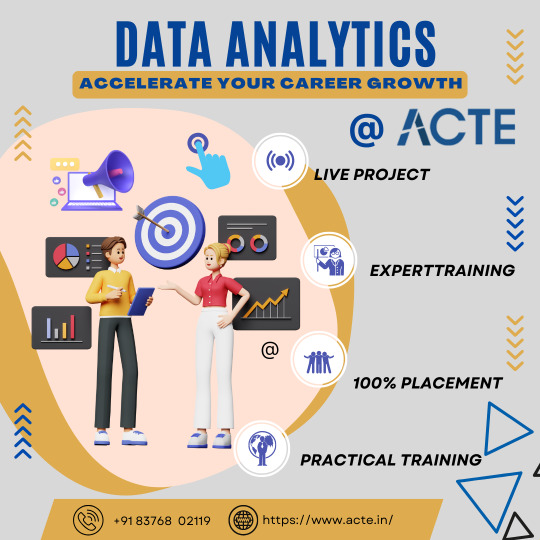
Data analytics is an exciting and profitable field that enables people and companies to use data to make wise decisions. You'll be prepared to start your data analytics journey by understanding the fundamentals described in this guide. To become a skilled data analyst, keep in mind that practice and ongoing learning are essential. If you need help implementing data analytics in your organization or if you want to learn more, you should consult professionals or sign up for specialized courses. The ACTE Institute offers comprehensive data analytics training courses that can provide you the knowledge and skills necessary to excel in this field, along with job placement and certification. So put on your work boots, investigate the resources, and begin transforming.
21 notes
·
View notes
Text
Is Business Analytics Hard

Here’s the breakdown:
The Basics Aren’t Scary: Business analytics uses tools you might already be familiar with, like Excel and data visualization software. Plus, the core concepts involve analyzing data to answer business questions — something we do intuitively in everyday life.
The Challenge Lies in the Details: As you delve deeper, you’ll encounter statistics, programming languages like SQL or Python, and data wrangling (cleaning and organizing messy data). These skills require dedication, but there are plenty of beginner-friendly resources and courses available.
Experience is Your Best Teacher: The real challenge lies in applying your knowledge to solve real-world business problems. Understanding your specific industry and translating data insights into actionable solutions is where the magic happens.
So, is Business Analytics Hard?
Not inherently. It requires a blend of skills: some technical know-how, analytical thinking, and a good dose of business acumen. But with the right resources and a willingness to learn, anyone can develop these skills.
Here are some tips to make your business analytics journey smoother:
Start with the fundamentals: Learn basic data analysis techniques, get comfortable with data visualization tools, and brush up on your Excel skills.
Embrace online learning: There are countless online courses, tutorials, and even boot camps dedicated to teaching business analytics.
Find a mentor. Connect with experienced business analysts who can guide you and answer your questions.
Practice makes perfect: Look for opportunities to apply your learnings to real-world data sets, even if it’s a personal project.
The Takeaway:
Business analytics is a rewarding field with excellent career prospects. Don’t be intimidated by the initial learning curve. With dedication and a passion for data, you can unlock the power of business analytics and make a real impact in today’s data-driven world.
7 notes
·
View notes
Text
How Artificial Intelligence is Transforming the Future of IT Services
In an age dominated by technological advancements, the integration of Artificial Intelligence (AI) has emerged as a revolutionary force, reshaping the landscape of IT services globally. As businesses strive to stay ahead in the digital race, it becomes imperative to understand the transformative power of AI in the realm of Information Technology. In this blog post, we explore how Artificial Intelligence is not just a trend but a fundamental shift that is redefining the future of IT services.
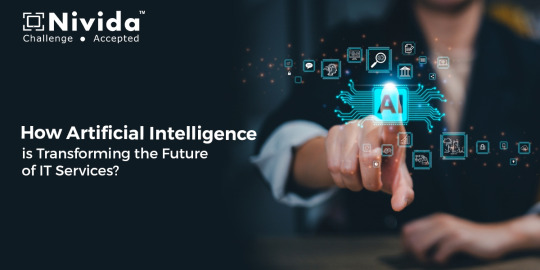
Embracing AI for Enhanced Efficiency
1. Intelligent Automation:
AI-driven automation has become the cornerstone of IT services, streamlining processes, and significantly reducing operational costs. Nivida Software, as a leading IT company in India, recognizes the pivotal role of AI in optimizing workflows and increasing overall efficiency.
2. Predictive Analysis:
Nivida Software leverages AI algorithms to analyze vast datasets, enabling proactive identification of potential issues and predicting trends. By staying ahead of challenges, our IT services ensure a seamless experience for clients across Gujarat and Vadodara.
Delivering Precision with AI-Powered Solutions
3. Customized IT Solutions:
As an innovative IT company in Gujarat, Nivida Software understands the diverse needs of businesses. AI allows us to create tailored solutions that align with the unique requirements of our clients, ensuring maximum impact and value.
4. Enhanced Security Measures:
The integration of AI in IT services goes beyond efficiency; it's about fortifying digital landscapes. Nivida Software employs AI-driven security measures to safeguard sensitive data and protect against evolving cyber threats, setting new standards for IT security in Vadodara. Pioneering AI at Nivida Software
5. Cutting-Edge Development:
Nivida Software is at the forefront of AI development, constantly pushing boundaries to create innovative solutions. As an IT company in India, our commitment to staying ahead in the technological curve positions us as a reliable partner for businesses seeking cutting-edge IT services.
6. Nurturing Talent:
The future of IT services lies in the hands of skilled professionals. Nivida Software invests in talent development, ensuring that our team remains well-versed in the latest AI advancements, delivering top-notch services across India, Gujarat, and Vadodara.
Conclusion
Artificial Intelligence is not merely a technological evolution; it's a paradigm shift that is reshaping the future of IT services. Nivida Software, as a forward-thinking IT company, embraces AI to deliver unparalleled solutions to clients in India, Gujarat, and Vadodara. The journey towards a digitally transformed future begins with Nivida Software – where innovation meets excellence in IT services.
7 notes
·
View notes
Note
*slides over a few coins* Do you have any Friede angst
-shoves the coins into my pocket- Yeah sure I gotcha. Have this that's totally not me self projecting based on HZ018.
Series: Pokemon Horizons
Characters: Professor Friede
--
“What, you're quitting? Why? You're one of the best here!”
“Hey man, I heard you were quitting. You think that's the right call?”
“While I don't really get why you're quitting, I wish you luck for your future endeavors Friede.”
Future endeavors? To be completely honest, Friede didn't have anything lined up. He gave easy answers and pleasant smiles to anyone that asked, slipping out lies as easy as breathing. Gave replies that appeased their hidden curiosity because one of the best researchers in the company quit such a good paying job? Surely it was for something bigger and grander.
All Friede knew was that had he stayed at his job any longer, he'd break.
He didn't know when it started to become wrong. Wasn't this what he wanted to become? Friede recalled a distant memory of his younger years when life felt a lot simpler. Heading to Professor Oak’s laboratory to get his first starter, being one of many children that day who discovered the wonders of Pokemon. Listening in on the Professor’s explanation sowed the seeds that'd later bloom into a burning want to become like his childhood hero.
Friede poured his all into that dream. Regardless of how he struggled with schoolwork, in making friends and getting good grades, he never gave up. Miss Lucca and her kind encouragement further pushed him to make it a reality. He wanted to be the student that proudly told his favorite teacher of his successes.
Friede worked hard for many years, pouring blood, sweat and tears into his education. From earning his bachelor's degree all the way to a PhD, he never gave up even during his lowest lows. It would be all worth it at the end, he told himself.
And he believed it initially. When he got hired to work at a relatively large company, Friede couldn't be happier. At last he could put his knowledge into practice!
(Where did it go wrong?)
He observed Pokemon, taking note of their behavior and analyzed it.
(When did it go wrong?)
Crunched the numbers inside a lab, hunched over his desk and typing away at the computer to store data.
(How did it go wrong?)
Repeating this process with each new project. Pulling all nighters to meet deadlines.
(Why did it go wrong?)
Finding himself becoming less motivated to do research work but forced himself because it was his job. It was what he spent many years achieving.
(What went wrong?)
This was what he wanted to do right? Friede wanted to become a professor so he could learn everything there was about Pokemon? Wasn't this job giving him that opportunity? To study Pokemon and analyze all that data within a lab with its sterilized walls and cold equipment and blank excel sheets and–
(Was… was he wrong? All this time was he…)
Friede had to quit. If he stayed any longer, forced himself to do work that chipped away at his genuine passion for research, he feared losing a fundamental piece of himself to… this. Whatever this was.
(This was burnout. This was discovering that he invested years of his life into something that might not be worth it).
They held a little farewell party for him, wishing him luck over a few rounds of drinks. Friede only drank enough to not be questioned. He didn't want to get drunk, despite how appealing it is to just forget about this for even a little while. Last thing he wanted for his lips to become loose, spilling things he kept hidden.
After that, Friede just… didn't do anything. His internal body clock still kicked him awake for his usual shift, often taking a few seconds to realise that he didn't have work to go to anymore. Instead of making the most out of his day, Friede simply laid back down, staring at the ceiling until he remembered to feed Charizard.
Friede didn't consider what he wanted to do beyond achieving his goal. He thought this was what he'd be doing for the rest of his life. What a foolish notion. Couldn't even last a year before he quit.
As much as he wanted to lie in bed all day, that too got old after a week or so. Friede opted to head out for his usual grocery shop with Charizard. His partner didn't feel like flying, so they simply walked to the market. Not like he could force a Fire-type whose flames were dulled. Like Pokemon like Trainer, huh?
At least during that trip, he came across Ludlow. An unexpected friend he made during his studying years. If he wanted to get away for awhile, away from all the books and expectations and looming deadlines, Friede could go to Ludlow. They'd go out to sea from Porto Marinada to fish all day, and he'd return with a clearer head, as if the sea had cleansed away the gunk weighing him down.
Friede didn't have to say anything. Ludlow took one look at him (with his disheveled hair, unkempt close and dead eyes) before inviting him out to a fishing trip.
A part of him didn't want to. He simply wanted to return back to his apartment and stare at the ceiling, fear of an unknown future paralyzing him. But this was Ludlow, a kind man who didn't have an obligation to spend time with him yet he chose to.
Friede took him up on that offer. Getting fresh air while the pair fished all day made him feel the most alive since he quit. Ludlow continued to invite him on fishing trips, trying his best to have him be more adventurous.
He often declined, giving non committal answers that Ludlow thankfully never pushed. Why should he put effort into something that'd likely not be worth it? Once was enough.
(Deep down, Friede knew those were simply excuses. He simply feared developing a passion that'd fizzle out and die when he realised it wasn't actually for him).
This went on for weeks until one day, Friede received a call from Miss Lucca. She wanted to meet up, and he respected her enough to clean up some before they met at the Treasure Eatery. It was somewhat bittersweet to see her again; she clearly had a future to look forward to, what with her having a child to raise.
Friede kept his answers vague to the somewhat probing questions. Miss Lucca always had the uncanny ability to see him through all the layers he put up. She had something to show him tomorrow, requiring him to wake up pretty early.
He accepted considering he had nothing better to do. What Friede ended up seeing was a Pikachu. He couldn't help but feel disappointed; he knew all that was documented about the species. Why did she want him to see this one in particular?
When Friede saw this small creature soar as high as the clouds, a spark lit up in his heart. For the first time in a long while, he felt excitement.
He missed this feeling, the surge of passion thought lost. Friede grasped onto it with all his might and was rewarded to a sight that showed him there were new horizons for him to explore. He just needed to take the first step again.
Friede did it once.
He could do it again.
19 notes
·
View notes